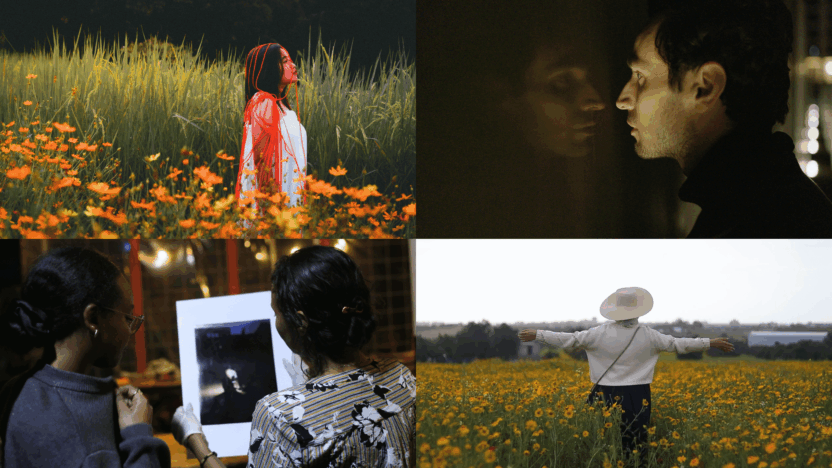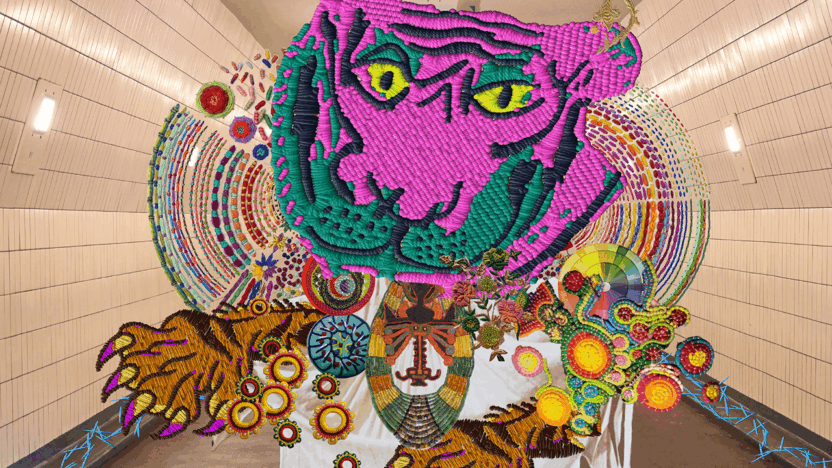Matthew Lax: Languages of power and love
With Focus: Matthew Lax, IFFR 2025 presents a decade-spanning look at the work of the American artist, writer and filmmaker. IFFR programmer Cristina Kolozsváry-Kiss takes an in-depth look at the approach and themes of Lax’s selected films and installation.

Matthew Lax is an interdisciplinary artist-filmmaker, and writer based between New York and Los Angeles. Our focus on Lax, spanning almost ten years of his practice, is divided into two programmes with some distinctive formal elements, but shared themes and investigations. Employing a range of technologies from 16mm to digital animation, his films are marked by a keen interest in and sensitivity to language. Behaviour and power permeates much of his work, rendered through deep readings of texts and play with translations and meaning. Also pervasive in Lax’s work is a dialectical theoretical framework, brought about by collaborations with actors and non-actors, combining genres and modes like melodrama, performance art, essay-film and documentary. We see across each programme a progressive adaptation of these frameworks, which directly explore queerness through more community-driven filmmaking and interrogations into his own biography.
The first programme, Reference material, incorporates a selection of four films that use cultural ephemera within our contemporary milieu to scratch at something deeper. We begin with AMERICAN FOLK (2016–18), which examines the cultural evolution of denim fabric from 17th century Dutch paintings of peasants clad in the tough stuff, to Gold Rush prospectors enamoured by its durability, and finally exploitative casting tapes that reduce the fabric (and the people wearing them) to symbols of sex and youth culture. Here we see an interest in narratives of provenance, production and labour that persist in other works.
Fabricated in the Actual Arctic (After Nanook) (2018) revisits the making of Robert Flaherty’s Nanook of the North (1922), with the discovery of a missing image by an Inuk artist from MoMA’s collection. The image depicts Inuk people participating in the production of the film on both sides of the camera, further complicating their role in the production of this seminal film that is also rife with deserved criticism over staging and exploitation. These two materials – the original film and the drawing – enter into a dialectical discourse about the ethics of documentary filmmaking.
In Lil’ Tokyo Story (2016), a shot-for-shot reimagining of the opening credits and climax of Yasujirō Ozu’s Tokyo Story (1953) in split screen Japanese and English deliveries1, Lax adapts the original material with great care and consideration, while also making some notable and poignant changes: the female characters are portrayed by Japanese men in drag. Through its queer lens, the film subverts the traditional notions of familial duty and sacrifice in Ozu’s classic, questioning how cultural memory resonates within queer contexts and how meaning can be lost or transformed through translation. The deliberate use of Los Angeles as a stand-in for Tokyo further complicates notions of place and cultural authenticity.
The programme concludes with the world premiere of Gay Men’s Book Club (2025), a 51 minute fly-on-the-wall documentary that observes a conversation between seven gay men (strangers to each other) discussing the book Elite Capture, How the Powerful Took Over Identity Politics (and Everything Else)2 by Olúfẹ́mi O. Táíwò. Lax himself acts as a co-facilitator of and participant in the conversation, alongside founding member of the Radical Faeries, and Jungian psychologist, Dr. Don Kilhefner, making space for each participant to share their reading of the text beside their own experiences and perspectives. Drawing inspiration from the observational style of Frederick Wiseman and the feminist collective approach of Lizzie Borden, the film offers an intergenerational and intersectional window into a queer community in Los Angeles, speculating toward a liberated future.
While Lax appears in almost all the films listed above (Lil’ Tokyo Story being the exception), none of these works are strictly biographical. It’s in the second programme, Man’s best friend, where Lax uses his own background as a quadruplet to foreground issues of trust, consent and bond building that were already present in his earlier works, though less explicitly. A TIRED DOG IS A GOOD DOG, PART ONE (2022) introduces us to dog breeding through his family’s farm where they breed collies, and the pups of puppy play, a kink community in which human-puppies realise a canine persona through dog attire and dog-like behaviour. The film imagines alternative familial (or pack) structures as lived by pups who feel a similar love for dogs but expressed in very different ways – namely, as a form of sexual exploration and identification. Opening with VHS footage of the filmmaker as a small boy handling a collie3 in a dog show, followed immediately with a scene in which adult Matthew is in his underwear learning to “how be a dog” from a pup in full gear, Lax investigates how “man’s best friend” has shaped humanity.
These questions are intended to linger and remain open as the project is an ongoing one, with its latest chapter, A TIRED DOG IS A GOOD DOG, PART TWO (2024), having its theatrical world premiere at IFFR. In this second installment, Lax puts time into building further trust within the pup community, as well as a severely traumatised rescue dog named Soba. Soba’s trainer Patrick assumes almost a narrator’s role as he explains and illustrates the nuances of Soba’s body language, in communicating her fears, anxieties and desire for attachment. This interplay of vulnerability and attachment is also evident in the scenes where multiple pups play together. It is perhaps because of Lax’s background that he seems to have an innate and generous understanding of both human and animal behaviour, evident in his interactions with Soba (most people would not be so steady with their camera work in the face of a barking dog), but also in his thoughtful reaction to being called out by one of the pups when Lax pushes the boundaries of their consent. Part Two also reflects on love and loss through the life cycles of Lax’s own dogs, a kind of sorrow often overlooked in the opera of human emotions, but one felt deeply by anyone who has shared their hearts with our non-human kin.
Lax often exhibits his work as installations – many of the featured films loop in various installed forms – which is why it is fitting that our focus conclude with a new installation, AN ANIMATED DOG READS JOHN BERGER, HARAWAY, AND KAFKA (2024). Presented on a flatscreen face-up inside a dog crate on the floor, the work features an animated collie give paw, perform tricks, and recite an exquisite corpse of texts by Donna Haraway, Franz Kafka and John Berger. The work brings together many of the themes featured in both programmes, most obviously that of the collie as Lax’s personal archetype for all things canine, that functions here as his avatar (the dog’s voice, face and gestures are rendered using motion-capture of Lax’s performance), and using reference materials as a means to expand upon themes of animal behaviour and the ways in which they illuminate what is human within us.
written by Cristina Kolozsváry-Kiss
1 The Japanese version with literal translations of the original dialogue into English subtitles, and the English version with literal translations of the English subtitles from the Criterion version back into Japanese.
2 Haymarket Books (May 3, 2022)
3 With careful attention you might have noticed the appearance of several collies in the first programme, including a collie audition tape in AMERICAN FOLK and a pack of collies in Fabricated in the Actual Arctic (After Nanook) cast as snow dogs.
A list with articles
-

CineMart launches Safe Harbour programme for stateless and at-risk filmmakers
Published on:-
CineMart
-
IFFR Pro
-
Press release
-
-

Rotterdam Lab announces open call producers for 2026, along with new Creators Lab for writers and directors
Published on:-
IFFR Pro
-
Press release
-
-

IFFR welcomes returning partners and announces Lynk & Co for 2026 edition
Published on:-
Press release
-
